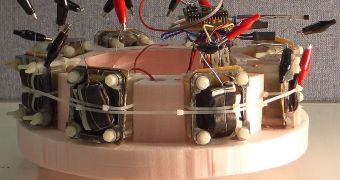Investigators at the Bristol Robotics Laboratory (BRL) announce the development of an artificial heart of sorts, a pumping device that can be used to transfer waste such as urine from humans to future generations of ecological robots (EcoBots). These machines have already demonstrated their ability to produce low-level power through the conversion of organic matter.
Based on shape memory alloys (a type of smart materials), the new device is modeled on the human heart. In the future, it could be widely used to pump urine into the so-called engine room of EcoBots. These machines are entirely self-sustaining, and they have already reached their fourth generation.
The BRL research group, a joint venture between the University of the West of England and University of Bristol, published details of their synthetic heart in the November 8 issue of the journal Bioinspiration and Biomimetics, e! Science News reports.
Researchers at the lab have been working on EcoBots for 10 years. All four generations of the machines use microbial fuel cells as a source of power. These cells contain living organisms that can effectively break apart organic matter to generate low levels of electricity.
The only byproduct EcoBots release is carbon dioxide, but the chemical released from breaking apart wastes is part of the primary carbon cycle, meaning that it is not counted against the ever-increasing amounts of CO2 that threaten our planet with global warming and climate change.
“We speculate that in the future, urine-powered EcoBots could perform environmental monitoring tasks such as measuring temperature, humidity and air quality. A number of EcoBots could also function as a mobile, distributed sensor network,” scientist Peter Walters says.
“In the city environment, they could re-charge using urine from urinals in public lavatories. In rural environments, liquid waste effluent could be collected from farms,” he adds. Walters is based at the University of the West of England Center for Fine Print Research, and is also a lead author of the study.
In addition to human waste, EcoBots can also use waste water, sludge, dead insects, and rotten fruits or vegetables to produce electricity. These types of fuels are not likely to run out anytime soon, making these machines highly-autonomous.
The synthetic injection pump the BRL team created will replace the conventional motor pumps that are currently used to fill the microbial cells. These pumps are very prone to mechanical failures, as well as to experiencing blockages. The new instrument circumvents all these issues.

 14 DAY TRIAL //
14 DAY TRIAL //